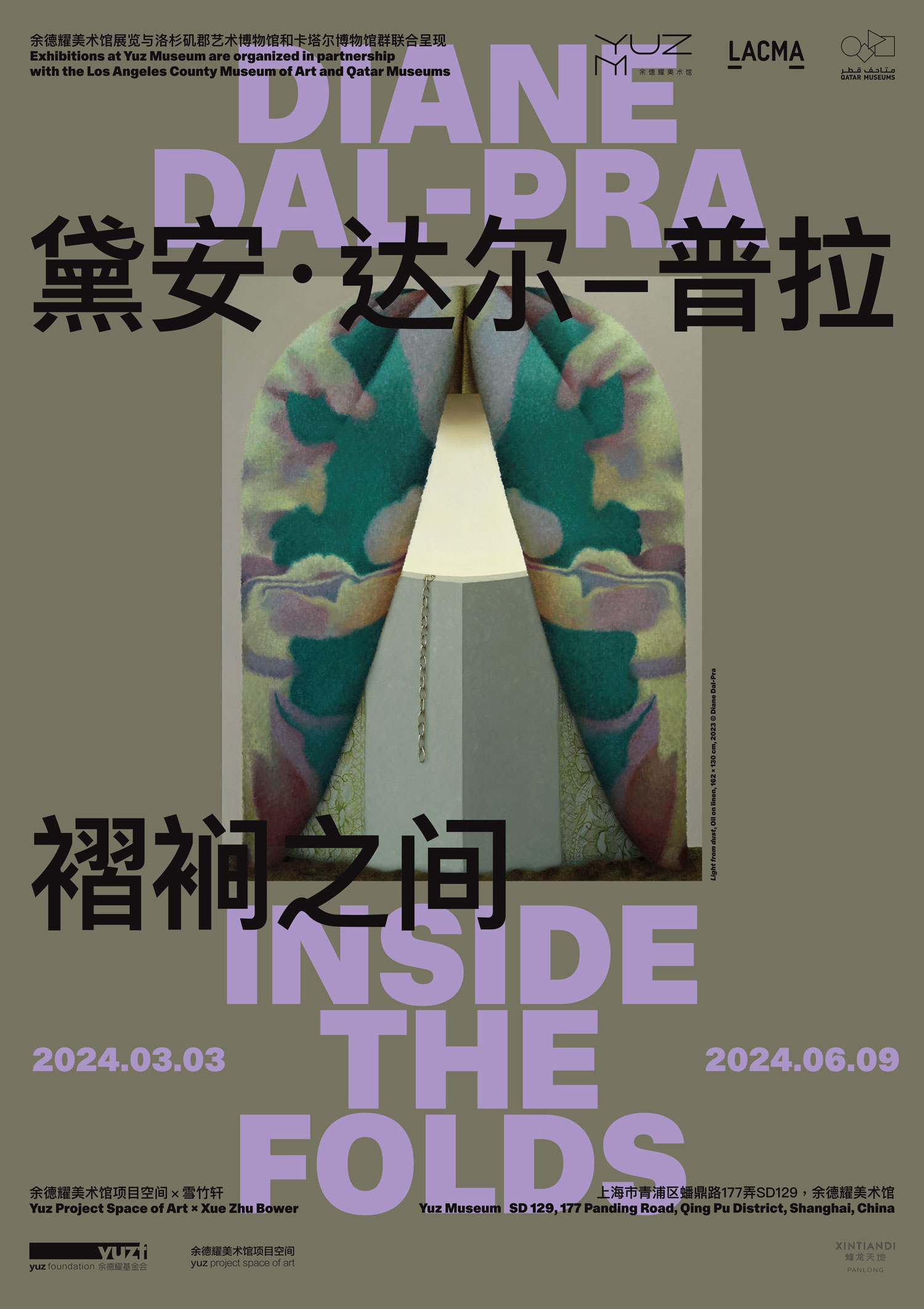展期 Period:
2024.3.3—2024.6.9
艺术家 Artist:
地点 Venue:
余德耀美术馆项目空间 Yuz Project Space of Art
新闻稿 Press Release:
2024年3月3日至2024年6月9日,余德耀美术馆项目空间将举办法国艺术家黛安·达尔-普拉(Diane Dal-Pra)在亚洲的首次个展“褶裥之间”。本次展览将涵盖艺术家于2021-2023年创作的十多幅绘画作品,呈现达尔-普拉对日常生活的细微体察以及对个人生命体验的内观自省。
人体与织物等日常生活中极其常见的图像构成了达尔-普拉绘画作品中的主体。她通常从构图出发,捕捉身体与周身事物之间的微妙关系,但并不寻求精准的叙事。达尔-普拉并不将织物视作刻画人物身体或创造情境时的附属,而是将身体与服饰、物体与覆盖物、空间和帷幔等关系置于同等地位,展现两者间彼此依附而又矛盾的双重情境。在过往系列作品的基础上,达尔-普拉围绕自身经历失眠或其他孤独与私密时刻的生命体验,延续并发展她对过渡状态和中间地带的兴趣,进一步探索介于身体与物体、意识与感知之间模棱两可的关系和状态。物跨越有机体和无机体的边界成为身体的延伸,身体则逐渐溶解、消隐于物的褶皱与肌理之中。对达尔-普拉而言,“存在的印记或痕迹就在那里,见证着已逝或即将逝去的一切”。在部分近作中,织物甚至占据主导地位,它们以拟人化的姿态暗示身体的缺席,展现存在与不存在、理性与畸变之间的模糊地带。
此次在余德耀美术馆项目空间的展览以“褶裥之间”为题,除了延续达尔-普拉长久以来对织物美学和褶子理论的研究兴趣和创作实践,同时也意在提示一种中间地带。德勒兹在有关“褶子(pli/fold)”的创造性哲学概念中,认为褶子是无所不在的,褶子本身就是“两者的褶子”,且永远处在两个褶子之间。这也在达尔-普拉对褶子诗学的理解和运用中获得延续,她认为褶皱“营造出一种空洞、亲密以及内外并存的可能性”。除了描绘衣褶、床上织物的褶皱、帷幔的垂褶等,达尔-普拉也有意在画面中创造不同形式的褶子,包括交错层叠的空间构建、对身体造型的折叠处理以及对微小细节的刻画等,在不同折叠的层面引发开放的诠释和联想。
达尔-普拉极具古典绘画艺术风格的创作沿袭自文艺复兴时期,也深受矫饰主义、超现实主义、 0世纪绘画史等不同时期的风格的影响。油画颜料具有时间性的特点,使艺术家对于画面层次的叠加、精致细节的刻画、氛围基调的营造成为可能。她用色极尽克制,通过精妙理性的构图,在凝思的过程中将时间沉淀并雕琢成那些如雕塑一般具有体积感和重量感的存在。这也使达尔 普拉无论描绘什么主题,其绘画都如Stilleben(静物画),呈现出一个脱离于忙碌现实之外的静谧的世界。她为每个微小琐碎甚至不值一提的时刻注入层层叠叠的肌理,在褶裥之间打开时间的缝隙,唤起人们各自的记忆、感知与想象,使人们得以从当下短暂抽离。
From March 3 to June 9, 2024, Yuz Museum is pleased to present “Inside the Folds”, the first major exhibition of the French artist Diane Dal-Pra in Asia at Yuz Project Space of Art. Comprised of over a dozen paintings created by the artist between 2021 and 2023, the exhibition will showcase Dal-Pra’s subtle observations of daily life and reflections on personal life experiences.
Dal-Pra’s paintings feature images commonly seen in daily life, such as the human body and textiles. She usually begins with composition, capturing the nuanced relationship between the body and the things around, but does not seek precise or defined narratives. Textiles are not regarded as accessories in the portrayal of human bodies or the creation of situations. Instead, Dal-Pra gives equal weight to the relationship between bodies and clothing, objects and covering, space and draperies, presenting the dual contexts in which they are contradictory but mutually dependent with each other. Building on her previous series of works, Dal-Pra continues to develop her interest in transitional states and in-between spaces inspired by her personal experience with insomnia and awareness of other lonely, private moments, further exploring the ambiguous relationships and states between bodies and objects, consciousness and perception. Objects cross the boundary between organic and inorganic bodies, becoming extensions of the body, while the body gradually dissolves and fades into the folds and textures of objects. For Dal-Pra, “the imprint or trace of a presence is there as a witness to what has gone or will soon go.” In some of her recent works, textiles even play a prominent role, whose anthropomorphic shapes suggest the absence of the body, revealing the ambiguity between presence and absence, rationality and aberration.
Titled as “Inside the Folds”, the exhibition at Yuz Project Space of Art not only carries on Dal-Pra’s long-standing interest and practices around the aesthetics of textiles and the theory of folds, but also intends to suggest an in-between zone. Folds are ubiquitous, according to Deleuze’s inventive philosophical concept of “fold (pli)”. The fold itself is “a fold of two folds” and always between two folds. DalPra extends this philosophy to her understanding and application of the poetics of folds. For her, folds “create a cavity, intimacy, the possibility of an interior and an exterior.” She depicts not only the pleats of clothes, the folds of bed sheets, and the drapes of curtains, but also intends to create different forms of folds by reflecting the construction of staggered and layered spaces, the folding of body shapes, and the description of minute details, inspiring open interpretations and associations on different levels of folding.
Dal-Pra’s works feature the artistic style of classical painting, which traces back to the Renaissance period, but have also been greatly influenced by other historical styles such as Mannerism, Surrealism, and the history of painting in the 20th century. Oil paint is temporal in nature, which makes it possible for the artist to superimpose layers of colours, depict fine details, and create atmosphere and tonality. Through ascetic colour choices and rational compositions, Dal-Pra precipitates and carves time into sculpture-like existences with a sense of volume and weight in the process of meditation. This also makes Dal-Pra’s paintings, regardless of the subject matter, resemble Stilleben (still life), presenting a peaceful and silent world that is detached from the busy reality. By infusing layers of textures into small, trivial or even unnoticeable moments, crevasses of time could be found inside the folds, where one could disconnect from the here and now, evoking memories, perceptions, and imaginations.

